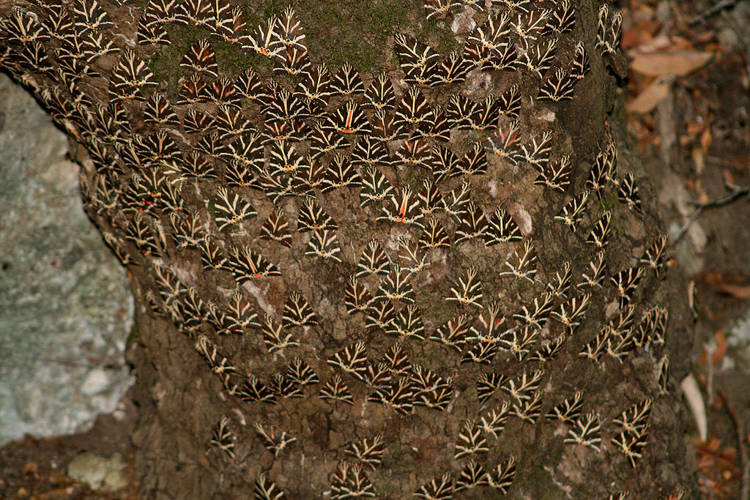The Greek island of Rhodes is home to a special biome called Petaloudes Valley, or the Valley of Butterflies, after the millions of endemic moths that cover almost every surface during the summer months.
Located on the western side of Rhodes Island, about 10 kilometers from 10 km from the airport and 25 km from Rhodes City, Petaloudes Valley hosts the only natural forest of Oriental Sweetgum trees (Liquidambar orientalis) in Europe. It’s the scent given off by these trees that attracts an endemic subspecies of Jersey Tiger moths called Euplagia quadripunctaria rhodosensis; huge numbers of moths congregate in this small valley, covering almost every visible surface almost as a living blanket.

Photo: Karelj/Wikimedia Commons
Every year, the spectacular migration of the Jersey Tiger moth to Petaloudes Valley begins around the end of May, after the rainy season, as the Jersey Tiger moths emerge from their caterpillar form. Attracted by the aroma of Oriental Sweetgum trees, they make their way along the island’s waterways, traveling dozens of kilometers towards the valley they helped name (petaloudes means ‘butterflies’ in Greek).
View this post on Instagram
Once they reach their destination, the swarms of butterflies begin to cover everything, from the lush foliage to rocks of all shapes and sizes. They prefer to sleep on the shady sides of trees or around the roots, and tourists are advised to admire the surreal views in silence, as loud noises can disturb the butterflies.
View this post on Instagram
Keeping quiet is more than a simple curtesy to the Jersey Tiger moth, as startling the tiny fliers and forcing them to fly more than they need to is a sure way to render the entire subspecies extinct. That’s because the butterflies don’t have stomachs, which renders them unable to feed. They survive on the fat deposits they store during their caterpillar stage, so they need to save up their energy.
View this post on Instagram
Startling the moths and causing them to fly off, can cause them to exhaust their energy reserves before they can reproduce, which can have a disastrous impact on colonies. In fact, due to the large number of tourists that visit the Valley of Butterflies every year, the endemic Jersey Tiger moth population has been greatly affected. Hopefully, the decrease in tourism caused by the Covid-19 pandemic can help the colonies recover.
View this post on Instagram
As the official Valley of Butterflies website explains, many visitors ignore the advice of staff and tour guides, and clap or whistle just to see the swarms of butterflies take flight. It’s an impressive sight, indeed, as the flapping of their wings allows viewers to see the orange of their underwings, but it is nothing short of animal cruelty.
View this post on Instagram
“The clapping and whistling produce ultrasonic sounds similar to those of bats,” the Petaloudes Valley website reads. “The butterflies feel threatened and try to escape frightened. Many of them die from shock or from depletion in their attempt to escape or even by crashing on rocks and trees. It is also important for them to stay still on the trees because they must keep their strength for their long journey in September.”
View this post on Instagram
After enjoying the cool, humid habitat of Petaloudes Valley during the hot summer months, the moths mate in late August and September. The women then leave the valley, travelling great distances in search of dark and safe places to lay their eggs in, before their natural life cycle ends. Then, as the rain season ends the next year, a new generation of Jersey Tiger moths emerges, and the cycle repeats itself.
While not of the same scale as Mexico’s Butterfly Forest, the Valley of Butterflies is definitely one of the must-see natural phenomena for lepidopterists and butterfly enthusiasts in general.












